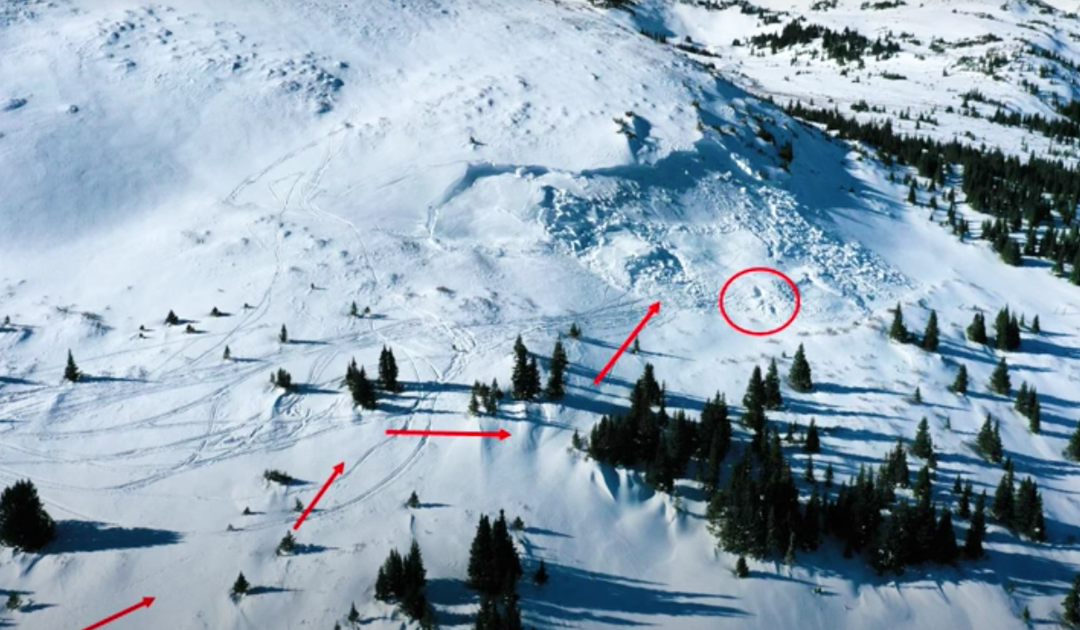“All of the fatal avalanche accidents we investigate are tragic events. We do our best to describe each one to help the people involved and the community as a whole better understand factors that may have contributed to the outcome. We offer these comments in the hope that it will help people avoid future avalanche accidents,” wrote the Colorado Avalanche Information Center (CAIC) in a report released on January 14 regarding a fatal accident that killed two Colorado Springs residents and their dog in the area of North Star Mountain along Hoosier Pass on January 8.
According to the final report from the CAIC, the two were snowshoeing at the time of the accident, likely down a Forest Service road off of Hoosier Pass toward Crystal Lake. While their intention was presumably a casual snowshoe hike, their trek became more dangerous due to a steep and snow-packed slope above their route.
There were no witnesses to this tragic accident, so the timeline of events for that day comes from evidence at the scene and accounts from friends.
The couple started snowshoeing from Hoosier Pass and as they continued along their route down a Forest Service road, it’s likely they unknowingly entered avalanche terrain amid poor conditions. Weather was stormy on the day of the accident and visibility would have been extremely limited. Recent and ongoing snow had resulted in a three-of-five avalanche risk rating in the area, with the potential to trigger large avalanches forecasted as ‘likely.’
An avalanche broke off above the couple on a slope that was 35 to 38 degrees steep, burying parts of the Forest Service road below as it ran 100 vertical feet downward at a width of 370 feet. The average depth of the avalanche was 6 feet with a crown made up of wind-drifted snow that was three to ten feet deep.
Concern was raised when the couple missed plans they had made in Breckenridge the following day. While the couple that was killed had not told friends that were contacted by authorities about a specific plan, one of the snowshoer’s phones pinged near Hoosier Pass on a location sharing app.
Search crews started in that area, locating the male’s vehicle at the Hoosier Pass summit. Evidence of an avalanche could be seen northwest of the pass, with crews locating tracks going into a debris field, but not out. The team found the couple and their dog completely buried near the toe of the avalanche later in the day.
The couple was later identified as Hannah Nash, 25, and Drake Oversen, 34, of Colorado Springs. They are remembered for their love for the outdoors. More can be read about Nash and Oversen here.
Undoubtedly a tragic situation, the Colorado Avalanche Information Center did point out a few mistakes that the couple made with the intention of teaching others about a life-or-death scenario.
1. The couple had not told anyone about their specific plan. One safety rule that should always be followed when it comes to outdoor recreation is to let someone know where you’re headed and when you’ll be back. This can expedite getting help should something go wrong.
2. The couple entered the backcountry amid dangerous conditions. Avalanche risk was forecasted and snow was falling. Entering backcountry terrain during conditions like this can amplify a number of risks, such as triggering an avalanche or getting lost. Always check the avalanche risk forecast prior to embarking on a backcountry adventure, found here.
3. The couple did not have avalanche safety training or avalanche safety gear. While it doesn’t seem like this couple was planning to enter avalanche-prone terrain, some basic avalanche safety training would have still been helpful. Basic knowledge of avalanche safety, including planning to follow routes that do not travel under steep slopes, is crucial to safely traveling Colorado’s backcountry during the snow season.
4. Based on evidence at the scene, the couple was traveling in close proximity to each other. In moments of doubt when it comes to avalanche-prone terrain, spreading out is important. This can help keep part of the party above the snow and able to assist should an avalanche occur.
5. The couple was traveling beneath avalanche prone terrain. This is dangerous, as avalanches can be triggered from below, even from a much flatter area.
The Colorado Avalanche Information Center concluded their report with the following advice:
“Even a short hike from a busy trailhead requires planning. There are many steep, avalanche-prone slopes in the Colorado mountains. Identifying terrain to avoid under current conditions is an important part of planning. You should always check the avalanche forecast so you know the level and location of the hazard and choose a route that maintains the level of risk you are both willing and prepared to face. Using safe travel methods, such as sticking to low-angle slopes and traveling one at a time, are important. Carrying the right equipment is also important, and for avalanches the bare minimum is an avalanche-rescue transceiver, and probe pole, and shovel. In any season, leaving a trip plan with someone outside of your group will help other people when they start looking for you.”
Condolences go out to those impacted by this loss.
Thanks goes out to search and rescue team members involved in this mission. If you’d like to support search and rescue in Colorado, you can do so by purchasing a CORSAR card here.
A video giving a full overview of this avalanche can be found below:
This content was originally published here.
